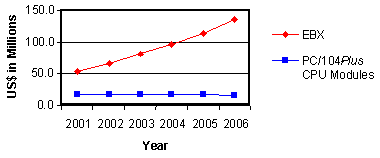VDC sees bright future for EBX form-factor embedded boards
Apr 2, 2002 — by LinuxDevices Staff — from the LinuxDevices Archive — 2 viewsNatick, MA — (press release excerpt) — In a recent study entitled 2001/2002 Merchant Computer Boards in Real-Time and Embedded Applications, Venture Development Corporation (VDC) noted that board vendors projected substantial growth in shipments of EBX form-factor motherboards during the period from 2001… through 2006. Vendors also projected that shipments of PC/104-Plus CPU modules would remain flat over the same period. These projections, shown in the exhibit below, indicate a compound annual growth rate (CAGR) of over 20% for EBX shipments. Shipments of PC/104-Plus CPU modules are now expected to decline by nearly 8%. Both are contrary to vendor projections made in year 2000. VDC contends that these trends are not independent of one another.
EBX and PC/104-Plus CPU boards

Designed as an “upgrade” to its predecessor (PC/104), PC/104-Plus [provides] the 32-bit PCI bus [in addtion to] the older, 16-bit, ISA bus. PC/104-Plus is, however, said to present some difficulties to board developers, as more tracks are needed to support the PCI bus on a small (3.8 x 3.6 in.), and already densely populated, PC/104 form-factor board.
Other than the potential drawback of its somewhat larger size (5.75 x 8 in.) and slightly higher cost, the EBX form-factor presents all of the benefits of PC/104-Plus. [Both PC/104 and PC/104-Plus] expansion modules may be stacked on an EBX board to add density and functionality while minimizing package volume. EBX may also be expanded through the use of PCMCIA cards.
Other advantages of EBX over PC/104-Plus may be attributed to its larger size. These include a more ready implementation of the PCI bus, potentially greater density and the ability to use the latest in microprocessors. Deployment of a Pentium IV or other processor that requires additional space for a larger heat sink on a PC/104-sized card may be impractical, if not impossible. Thus, the larger EBX form-factor inherently allows designers to achieve greater performance in their embedded designs.
We believe that the projected growth of the EBX form-factor is due to its functionality and its practicality, as well as its advantages over PC/104-Plus in terms of density and performance. When upgrading from a PC/104-based design, embedded developers who are not constrained by the larger size may view EBX, rather than PC/104-Plus, as the next logical step in the evolution of their systems.
Note: VDC is presently conducting an online survey of merchant computer board users to determine their preferences.
This study is part of a year-long planning service on Merchant Computer Boards in Embedded and Real-Time Applications which includes the following deliverable reports: Volume I: Switch Fabric Architectures; Volume II: Merchant Computer Boards in Embedded and Real-Time Applications, Market Analysis Report; and Volume III: Merchant Computer Boards Application Analysis Report. In addition, sections of Volume II — which examine: VME; PCI; CompactPCI, ISA and PMC; and Motherboards and PC/104 family boards — are available separately. Also sections of Volume III are available separately that address: Telecom/Datacom Applications; Industrial Automation Applications; Other Applications (medical, military/aerospace, scientific instruments, transportation, general business, retail, etc.). Prices for the reports or report sections range from $1,995 to $19,950 for the entire planning service.
Major emphasis is placed on gathering data directly from decision makers at vendors that manufacture these products, and at firms that purchase these products. Comprehensive interviews are conducted with both vendors and users. In addition, an extensive online survey is conducted among users. This data is supplemented by secondary research for relevant information in technical and business literature, as well as government, trade association, professional society, corporate and industry reports.
This article was originally published on LinuxDevices.com and has been donated to the open source community by QuinStreet Inc. Please visit LinuxToday.com for up-to-date news and articles about Linux and open source.